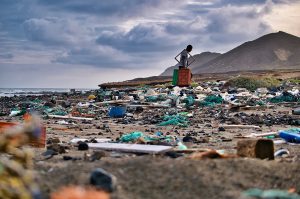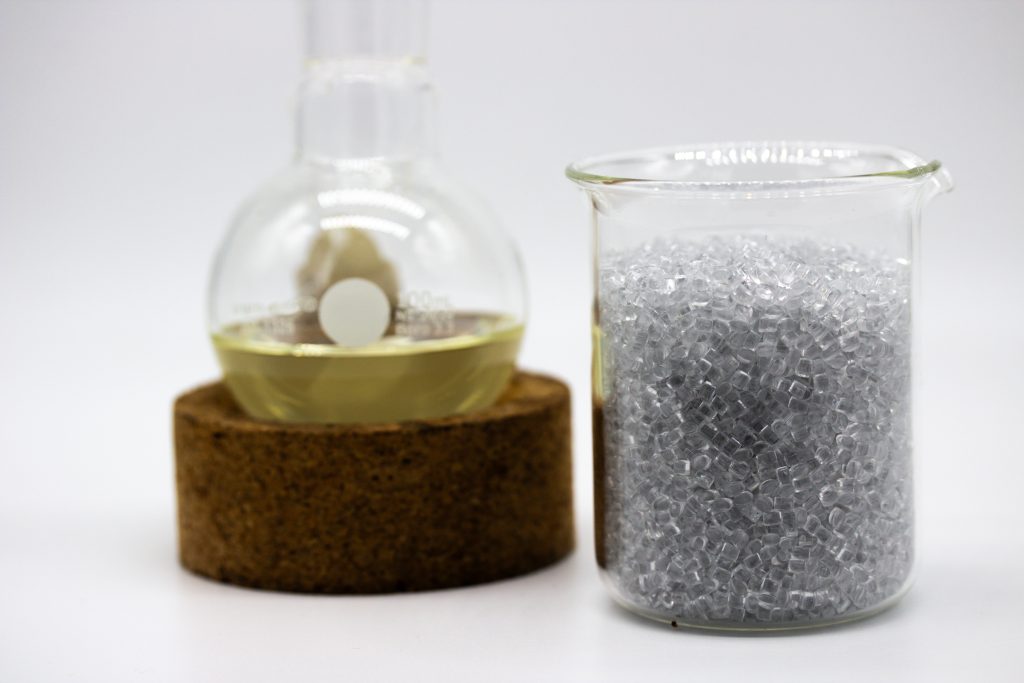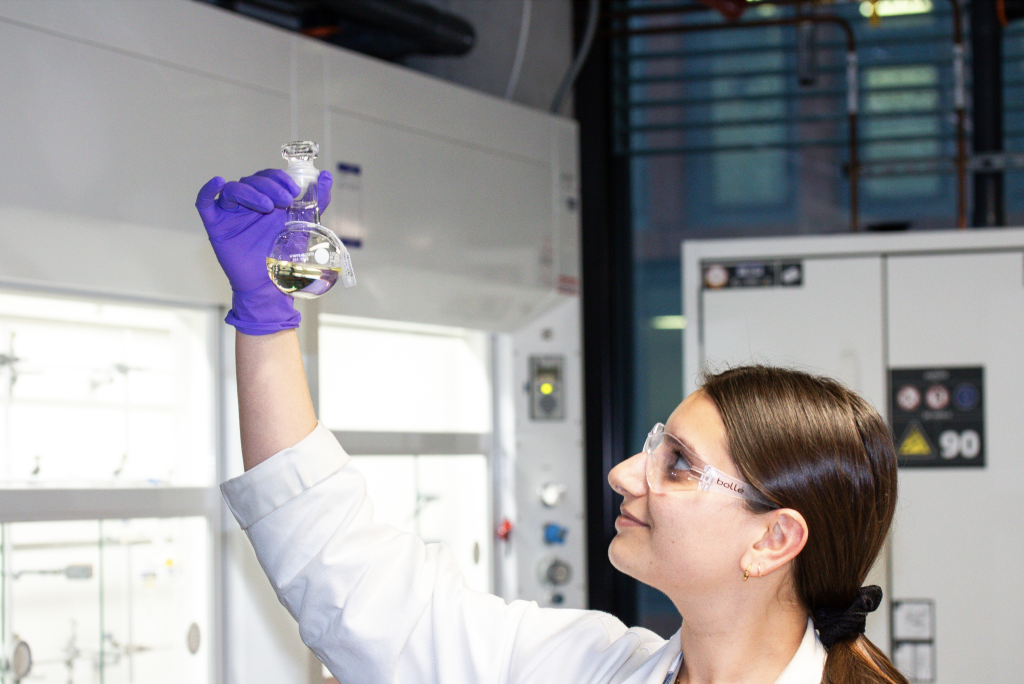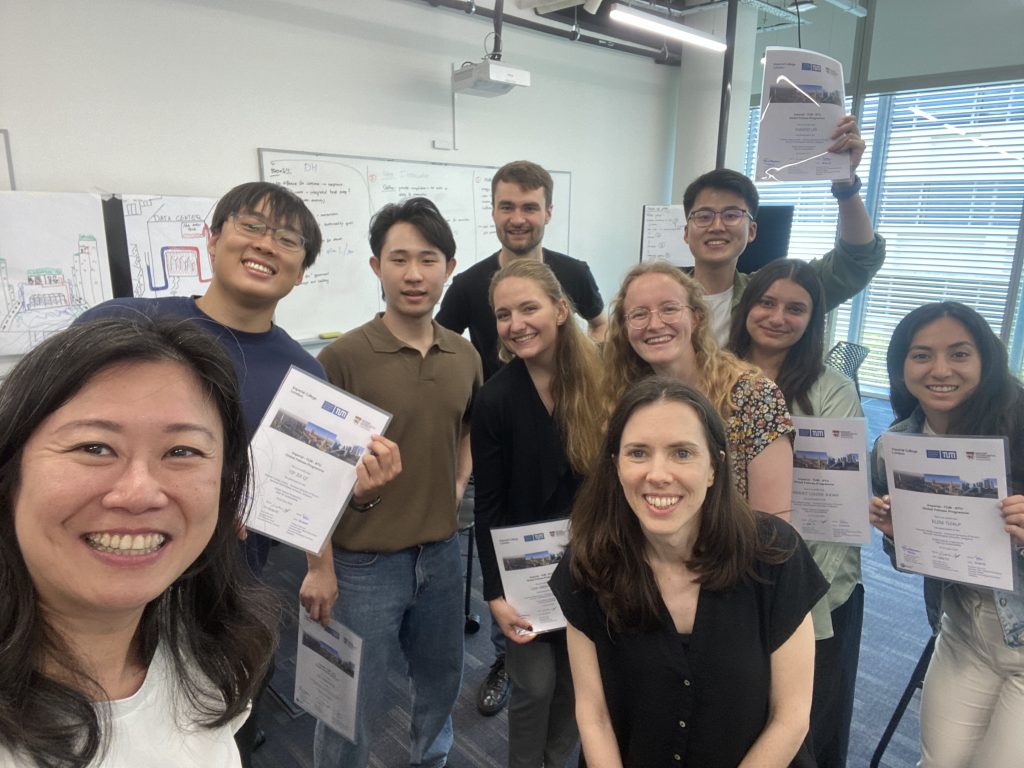PhD student Harriet Judah, from the Department of Chemistry, takes us on a journey through the ages to explore the use of plastics and modern solutions to the current plastic crisis! Harriet is part of the Brandt-Talbot Research Group, which studies and develops ionic solvents for use in chemical recycling.

When contemplating humanity’s most impactful creations, both remarkable and detrimental, one entity comes to mind: plastics. Considering this, I’d like to take you on a journey through time and innovation.
It was mid-19th century when plastics first emerged as a ground-breaking innovation, starting with Alexander Parkes’ Parkesine in 1862 and the synthesis of Bakelite by Leo Bakeland in 1907. These inventions ushered in a new age: the Plastic Age, transforming industries and everyday life.
In the following years, global plastic production skyrocketed, reaching 391 million tons per year by 2021. That’s equivalent to 31.5 million London buses, to put things into perspective. Plastics have woven themselves so deeply into the fabric of our lives (and clothing) that it’s impossible to navigate life without them.
While plastics have revolutionised countless applications, the rise of single-use and micro-plastics has led to severe environmental issues, polluting oceans, waterways and land. The persistence of plastics, coupled with the challenges of recycling, has created a pressing dilemma.
A new chemical innovation
Efforts to address the plastic problem have led to the exploration of chemical recycling, specifically depolymerisation. Unlike mechanical recycling, depolymerisation breaks down plastic polymers into their original monomer constituents, enabling the transformation of previously unrecyclable plastics into high-quality feedstocks.
Much like taking apart an intricate LEGO masterpiece, breaking it down into its individual building blocks. Depolymerisation is the delicate hand that deconstructs each piece until all that is left are individual monomers, ready for new, infinite recycling possibilities.
This innovative process paves the way for a circular economy, offering a sustainable solution to the plastic pollution crisis, one building block at a time.
However, addressing the plastic issue requires a multi-faceted approach, involving public awareness campaigns, regulations promoting recycled materials and investments in recycling technologies, whilst also encouraging the development of biodegradable and recyclable plastics to re-mould our plastic-reliant society.
And so, our whistlestop tour through time and innovation brings us to present day: at the frontline of research, where scientists at Imperial are fighting to make the world a more sustainable place for our future generations.
How we’re developing ionic liquids at the Brand-Talbot research group
In the Brandt-Talbot research group, we are making materials that are conventionally derived from fossil-fuel resources more sustainable. We are achieving this by exploiting low-value waste streams such as biomass and plastic waste, effectively converting them into high-value products – also known as valorisation.
Our most active areas of research include (but are not limited to) preparation of biodegradable films and carbon fibres from biomass derived compounds such as cellulose and lignin, and of course, chemical recycling of waste plastics to recover monomer feedstocks.
Special solvents called ionic liquids are embedded at the heart of our research. Ionic liquids are salts that exist as liquid at low temperatures. Unlike traditional salts that have extremely high melting points like sodium chloride (801°C), ionic liquids are characterised as melting below 100°C, often times below room temperature.

They are liquids composed entirely of ions, consisting of a cation and an anion. Due to their ionic nature, ionic liquids have several properties that distinguish them from traditional molecular solvents: low volatility, high thermal stability, electrical conductivity and solvation of a wide range of compounds.
They are often called ‘designer solvents’ due to the ability to select counterion combinations that may intentionally bestow properties to suit a desired function. Thus, the possibilities are seemingly endless for these i(c)onic liquids!
Within the context of plastic recycling, ionic liquids serve as dual functioning solvents and catalysts in the depolymerisation of poly(ethylene terephthalate) (PET).
All polymerisations are governed by a critical temperature. In most cases, below this critical temperature, polymerisation is favoured and above it, depolymerisation occurs. In principle, all polymers can be depolymerised if the right temperature is applied. However, some polymers require such high temperatures that it is neither economically or environmentally feasible.
High temperatures such as those required for depolymerisation can also result in polymer decomposition or unwanted side-products before depolymerisation is achieved. PET is an ideal candidate, as it contains chemical linkages that are easier to depolymerise and a relatively low critical temperature. Moreover, PET is the worlds’ most produced polyester, so recycling methods are in high demand.

Noble efforts have been made to make the industrial PET depolymerisation dream into a reality. By far, the most successful has been by perPETual Technologies, who are currently operating a commercial scale PET depolymerisation plant capable of processing over 3 million used plastic bottles a day (~8,700 tons/year), with plans for expansion in the works.
Others worth mentioning include Loop Industries and Ioniqa Technologies, who are both at the early commercial-pilot plant level. The journey towards widespread adoption of PET chemical recycling, though promising, is not without its challenges.
A recent life cycle assessment demonstrated that PET depolymerisation can perform worse than virgin PET production, with post-consumer PET collection and processing, monomer recovery and electricity as the top contributors. However, PET depolymerisation did result in lower fossil fuel depletion!
Ionic liquids have found themselves at the forefront of PET recycling research as they happen to be rather good at catalysing its depolymerisation. In the Brandt-Talbot group, we are particularly interested in ‘hydrolytic depolymerisation’ – that is, breaking down PET with water – as it produces the feedstock monomers used to prepare PET.
It is generally accepted that the ion pairs cooperatively bind to the ester-linkages in the PET and water molecules, making the ester ‘weaker’ and the water ‘stronger’ to facilitate the reaction. Though this is the subject of much debate and conclusive evidence is still lacking. Their ionic nature opens up whilst their thermal stability presents greater processing advantages and the potential for solvent/catalyst recovery and recycling, meaning a truly circular process can be realised.
Working at Imperial College London
On a personal note, I am profoundly grateful for the privilege of conducting research in a field that lies close to my heart. The pursuit of knowledge can be a treacherous path, and sometimes I question why I embarked on this journey at all, but it gives me peace knowing that the work I am doing is not in vain.
I’ve been incredibly fortunate to travel globally and present my research at conferences throughout my PhD. This year, Imperial selected me for the Global Fellows Programme on Data for Sustainability. During this week-long initiative at Nanyang Technological University in Singapore, I collaborated with international students on a project aimed at tackling data storage. It was a truly unforgettable experience.

Working in the Brandt-Talbot group, I am constantly reminded of the privilege it is to collaborate with like-minded individuals who not only share core-values, but also bring a diverse range of perspectives.
Their influence has not only enhanced my scientific abilities but, most importantly, has contributed to my personal growth; making me a better scientist and a better individual. And so, as I sat in my potential supervisors’ office on that rainy day in London, I could never have foreseen the extraordinarily unexpected journey that has unfolded over the past three years!